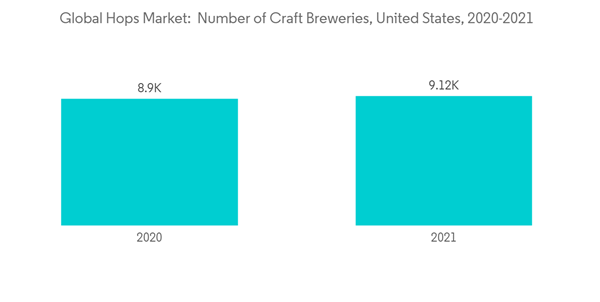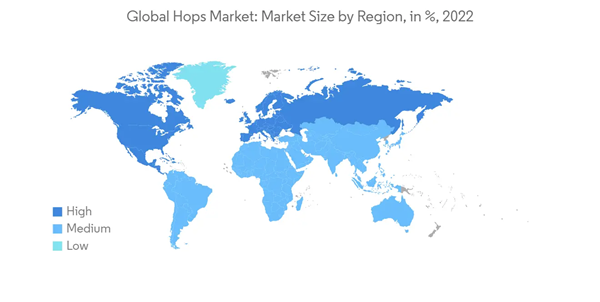Key Highlights
- The hop plant is a member of the cannabaeceae family, mainly used in bittering, flavoring, and as stability agents in beer. Hops are also used for several purposes in other beverages and medicinal herbs. A transitional shift in the demand for bittering hops from aroma varieties and a positive trajectory in the growth of craft breweries across the world are driving the global hops market.
- According to the United States Department of Agriculture (USDA), the United States continues to be the leading supplier with a 96% market share. Hong Kong re-exported 72% of its hop imports to other markets in the region, retaining 28% for local breweries. Despite the COVID-19 pandemic, domestic beer sales were stable, reaching USD 867 million in 2022, and will grow to USD 1.1 billion by 2026. The steady growth of beer sales is likely to encourage more local breweries to boost their production, increasing demand for US-quality hops. This will boost the growth of the hops market in the coming years.
- Europe was the fastest-growing market in 2021, with the United Kingdom and France leading the regional market. The United Kingdom imported 1,279 metric tons of hop cones in 2021, followed by France, with total imports of 684 metric tons during the same year. Apart from imported hops, Europe has also witnessed a steady revival in the cultivation of hops in Germany, where the production stood at 8.7 million metric tons in 2020, which has increased compared to the previous year. These factors are boosting the region to grow in the coming years.
Hops Market Trends
Craft Beer is Elevating the Demand for Bittering Hops
- As craft breweries expand globally, the demand for bittering hops has significantly shifted away from aromatic varietals, dominating the fresh or dried hop market. According to a study by the Worldwide Brewing Alliance, beer is the most consumed alcoholic drink globally and the third most consumed after water and tea. The global hops market is anticipated to rise considerably during the forecast period.
- In 2021, the market was growing at a steady rate, and with the rising adoption of strategies by key players, the market is expected to rise over the projected horizon. In the United States, the retail craft brewery market was valued at USD 26.8 billion in 2021, witnessing a growth of 8% in volume sales and accounting for 13.1% of the total beer market in the United States in terms of volume. Simultaneously, the number of craft breweries in the United States grew to 9,118 in 2021, a 4.4% increase over 8,905 in 2020, as per the Brewers Association.
- Moreover, according to a study by Barth-Haas, the demand for aromatic hops and production slightly decreased due to the pandemic in the country when compared to the previous year of 2019 (Perle with 5,481 metric tons, Mandarina Bavaria with 673 metric tons, and Hallertauer Mittelfrüh with 757 metric tons). However, the production of bittering hops such as Polaris and Herkules increased in the year 2020, respectively, during the same year.
- The growing inclination of consumers toward craft beer resulted in the establishment of 213 new craft breweries in 2020 in the United States. As a result, the growing demand for craft beer is inflicting a positive impact on the demand for bittering hops, especially in the United States and Germany, thus, driving the overall hop market.
Europe - The Fastest Growing Market
- Europe was the fastest-growing market for hops in 2022, which is determined by both growing imports and an expansion in the area under hop cultivation, driven by an ever-growing demand for beer. Germany is the world's second-biggest producer of hops after the United States. However, the heatwaves and drought of the summer severely affected production, particularly of early-maturing varieties in 2022.
- The Russia-Ukraine war disrupted local beer brewers' hops and equipment supplies, forcing them to seek domestic alternatives as they strived to keep their range of beers flowing. Three brewing companies collaborated to block Russian brewers' access to US and European hops, which allowed Russian businesses to expand in the hops market while foreign rivals vacated the market.
- The import market is dominated by the United Kingdom, France, Spain, and Germany, each importing a total of 1,279, 684, and 631 metric tons of hops in 2021, respectively. Moreover, Europe is the largest beer-consuming region in the world, with the Czech Republic holding the highest share in the per capita consumption of beet at 143.3 liters, followed by Germany with 104.2 liters per capita, Poland with 100.8 liters per capita, Ireland with 98.2 liters per capita, and others.
- Nearly 2,600 farms in the European Union grow hops, covering 26,500 ha with 60% of the total surface area used for hop-growing worldwide. Hops are grown in 14 European Union (EU) countries. Around 17,000 hectares are used for hop cultivation in Germany, accounting for 60% of the European Union's hop-growing acreage and about one-third of the surface area devoted to hop cultivation worldwide. The other main EU producers are Czech, Poland, and Slovenia. As a result, the demand for hops in the region also rose significantly and is further anticipated to witness robust growth during the forecast period.
Hops Industry Overview
Additional Benefits:
- The market estimate (ME) sheet in Excel format
- 3 months of analyst support
This product will be delivered within 2 business days.










